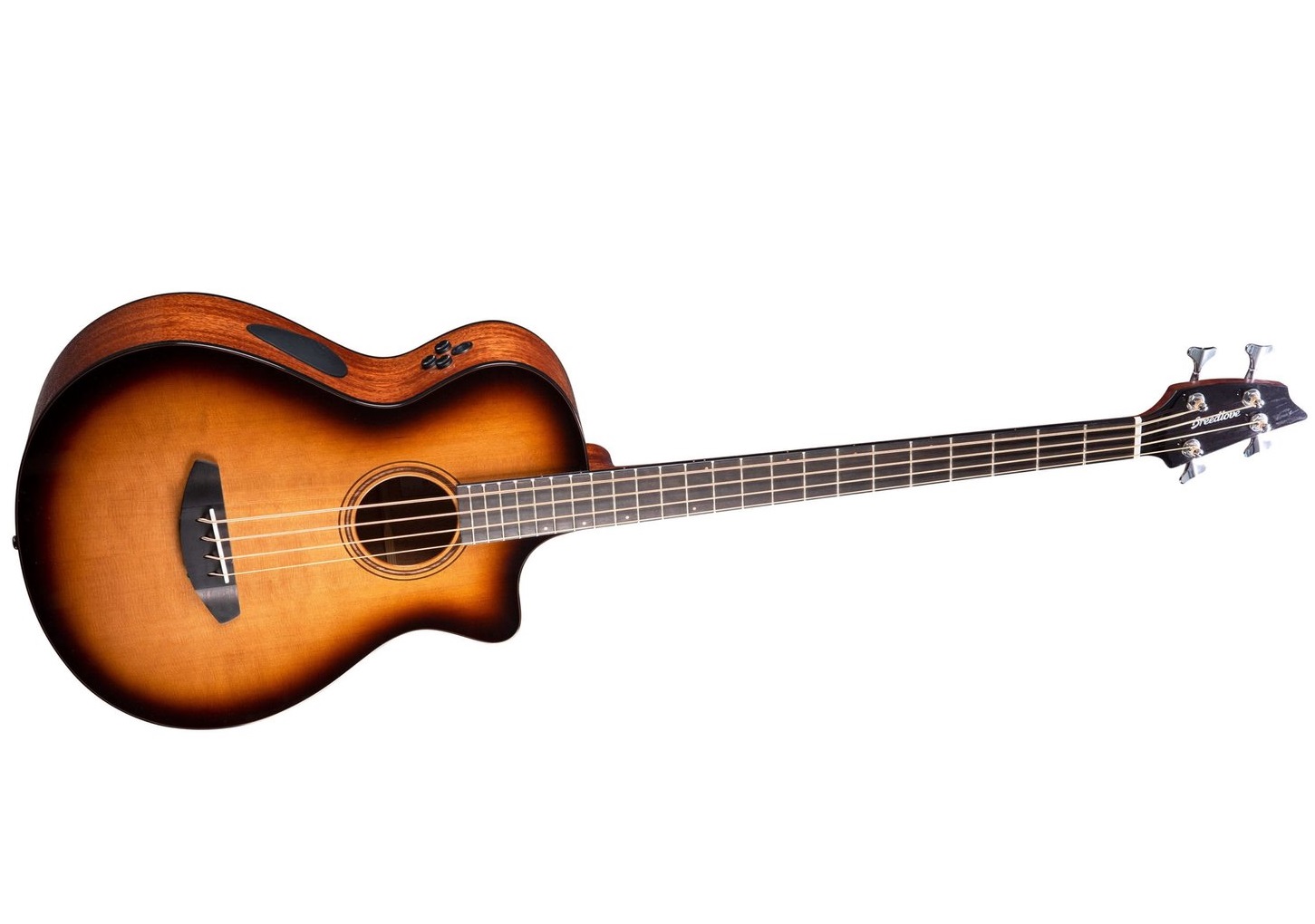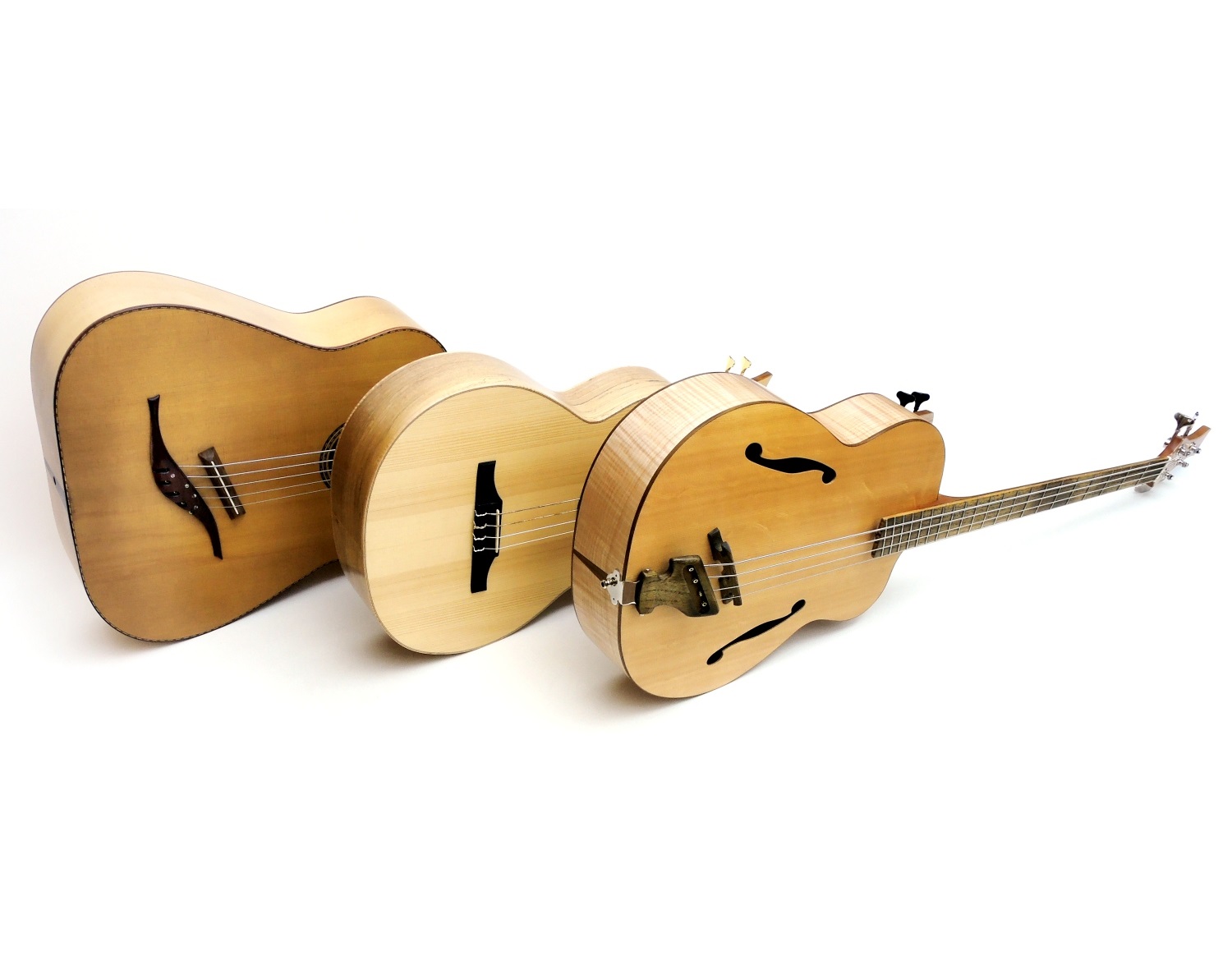Acoustic bass guitar
Plucked Instruments
America
Between 1901 and present
Video
The acoustic bass guitar is a fretted string instrument designed to produce deep, resonant tones similar to those of a traditional double bass. Unlike the standard electric bass guitar, the acoustic bass guitar generates sound through its hollow wooden body, which amplifies vibrations produced by the strings. It typically has four strings, though some models feature five or six strings for extended range. The instrument is widely used in various genres, including folk, jazz, country, and acoustic rock, offering a warm, natural tone that blends well in unplugged settings.
Type of Instrument: The acoustic bass guitar falls into the category of stringed instruments, specifically within the subcategory of bass instruments. It operates on similar principles as an acoustic guitar but is tuned like an electric bass, usually E-A-D-G from the lowest to highest string. This tuning is identical to that of the double bass and the electric bass guitar, allowing bassists to transition seamlessly between these instruments. Some variations include fretless models, which provide a smoother, more fluid tone, and hybrid models that incorporate built-in electronics for amplification.
History of the Acoustic Bass Guitar
Origins and Evolution
The acoustic bass guitar has its roots in the desire for a bass instrument that could be played acoustically, much like an acoustic guitar. While the double bass and electric bass guitar have been the dominant choices for bassists, the acoustic bass guitar emerged as an alternative in the 20th century. The first commercially available acoustic bass guitars were introduced in the 1950s and 1960s. However, it wasn’t until the 1980s that the instrument gained popularity, particularly through manufacturers like Ovation, Fender, and Guild. The rise of unplugged performances in the 1990s further solidified its place in the music industry.
Today, acoustic bass guitars come in a variety of designs, with improvements in amplification, tonewoods, and playability. Some feature onboard electronics for greater versatility, making them ideal for both studio and live settings.
Construction and Design
Acoustic bass guitars share many construction features with standard acoustic guitars but are built larger to accommodate the lower pitch range. The body is typically made of tonewoods such as spruce, mahogany, or maple, which contribute to the instrument’s resonance and tonal qualities. The neck is usually constructed from mahogany or maple and features a rosewood or ebony fingerboard. The scale length varies but generally falls between 30 and 34 inches, slightly shorter than a double bass but longer than a standard acoustic guitar. The soundhole is located in the center of the body, allowing the natural amplification of sound. Some models include a cutaway design for easier access to higher frets. Many acoustic bass guitars are equipped with piezoelectric pickups and onboard preamps, enabling amplification when necessary while retaining the acoustic tone.
Types of Acoustic Bass Guitars
Fretted Acoustic Bass Guitar – The most common type, featuring metal frets that allow for precise intonation and easier playability.
Fretless Acoustic Bass Guitar – Lacks frets, providing a smoother, more expressive sound similar to an upright bass.
Four-String Acoustic Bass – The standard version, tuned E-A-D-G, suitable for most genres.
Five-String Acoustic Bass – Adds a low B string for extended range.
Six-String Acoustic Bass – Includes both an extra low B and an additional high C string for expanded versatility.
Hybrid Acoustic-Electric Bass – Equipped with built-in electronics for amplified performances.
Playing Techniques and Sound Modifications
Playing techniques for the acoustic bass guitar vary based on musical style. Standard fingerstyle plucking is the most common method, allowing for dynamic control and articulation. Some players use a pick for a sharper attack and increased clarity. Slap and pop techniques, often associated with electric bass, can be adapted to the acoustic bass for percussive effects.
Sound modifications can be achieved through different string types, such as roundwound, flatwound, or tapewound strings, each providing distinct tonal qualities. Additionally, many acoustic bass guitars feature onboard equalization (EQ) settings when equipped with electronics, allowing for tone shaping when amplified.
Applications in Music
Genres and Styles
The acoustic bass guitar is used in a variety of musical contexts. In folk and country music, it provides a warm, natural bassline that complements acoustic instrumentation. Jazz musicians appreciate its upright bass-like qualities, making it a suitable choice for unplugged performances. In pop and rock settings, the acoustic bass guitar is often used in acoustic sets or unplugged sessions. It is also commonly found in Latin and world music genres, where its organic sound blends well with traditional instruments. The acoustic bass guitar is ideal for intimate acoustic settings, coffeehouse performances, and studio recordings where a natural bass sound is desired.
Choosing an Acoustic Bass Guitar
When selecting an acoustic bass guitar, several factors should be considered. The choice of tonewood influences the instrument’s sound quality; spruce tops offer brightness, while mahogany provides warmth. The scale length affects playability, with shorter scales being easier for smaller hands. A cutaway design allows for better upper-fret access. Players should also decide whether they need built-in electronics for amplified performances. Testing multiple models for comfort, sound, and feel is essential before making a purchase.
Maintenance and Care
Proper maintenance is crucial to prolonging the life of an acoustic bass guitar. Regular cleaning of the body and fretboard prevents dirt buildup. Humidity control is essential, as extreme moisture or dryness can cause wood warping. Strings should be changed periodically to maintain optimal sound quality. The tuning pegs and bridge should be checked for stability, and any electronics should be tested regularly to ensure proper functionality. Storing the instrument in a padded case helps protect it from damage.
Advantages and Disadvantages
Advantages: The acoustic bass guitar has several advantages and disadvantages, making it a unique instrument suited for specific musical situations. One of its primary advantages is its portability and ability to produce deep, warm tones without requiring an amplifier, making it great for unplugged sessions, intimate performances, and casual jamming. It also offers a natural, resonant sound that blends well with acoustic instruments, making it ideal for folk, jazz, and unplugged rock settings. Additionally, the acoustic bass is often easier to transport compared to its electric counterpart, eliminating the need for extra gear like amplifiers and cables.
Disadvantages: However, there are also some drawbacks to consider. Acoustic bass guitars tend to have lower volume levels compared to electric basses, often requiring amplification in larger venues or ensemble settings. They also usually have a larger body size, which can be cumbersome to play for some musicians, especially for extended periods. Another disadvantage is that they generally have a limited tonal range and sustain compared to electric bass guitars, making them less versatile for certain music genres. Furthermore, maintaining an acoustic bass can be more challenging due to factors like humidity affecting the wood, leading to potential warping or tonal inconsistencies. Despite these limitations, the acoustic bass guitar remains a valuable instrument for players seeking a natural, unplugged bass experience.
The acoustic bass guitar is a versatile and expressive instrument that has found its place in multiple genres and musical traditions. Whether played in an intimate acoustic setting or amplified for larger performances, it offers a distinct tonal character that enriches any musical ensemble.
FAQ
How is an acoustic bass guitar constructed?
An acoustic bass guitar features a hollow wooden body with a long neck and a fretted fingerboard. It typically has four strings, though five and six-string versions exist. The body is designed to amplify sound acoustically, much like a standard acoustic guitar. A soundhole is present to enhance resonance and projection.
What materials are used in an acoustic bass guitar?
Acoustic bass guitars are made from tonewoods like spruce, mahogany, or maple for the top, back, and sides. The neck is often mahogany or maple, while the fretboard is usually rosewood or ebony. The strings are typically made of phosphor bronze or nickel to provide deep, warm tones.
What are the advantages of an acoustic bass guitar?
The acoustic bass guitar provides a natural, resonant sound without requiring an amplifier. It is portable, making it great for unplugged performances and practice. Its warm and deep tones suit various musical styles. Additionally, it allows players to experiment with fingerpicking and strumming techniques.
 Links
Links
References
Other Instrument
Categories



















